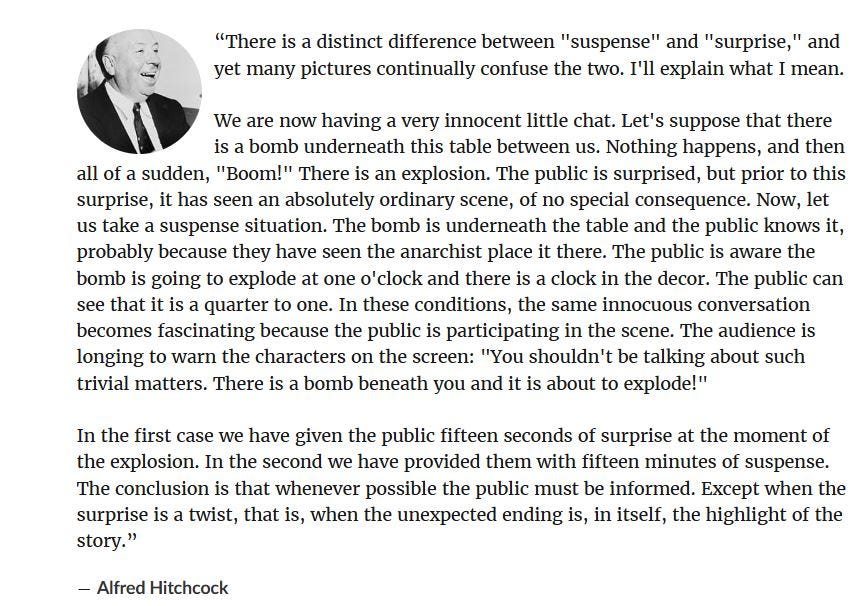How to Build Dramatic Tension Like a Pro
What makes it so hard to put down a book past your bedtime? Is it the gripping plot, or the gnawing need to know what happens next to your favorite character? It’s the tension—that ever-present feeling that something big is just around the corner, the sense of waiting for the other shoe to drop.
Often called dramatic tension, this is what keeps readers saying, “Just one more chapter.” (And we both know that one is never enough.) But how do skilled writers create and maintain this kind of tension—the kind that makes a book truly unputdownable? It all comes down to one essential truth: readers crave resolution.
Hitchcock’s Bomb Theory: The Power of Suspense
Alfred Hitchcock, the master of suspense, had a famous way of explaining how tension works. He called it the Bomb Theory.

That’s suspense. That’s tension.
Surprise is a moment. Suspense is an experience.
This principle applies beyond thrillers and horror. Readers don’t just want to see what happens—they want to feel the weight of what’s coming. That’s what makes tension so powerful. The emotions run high with every tick of the clock, every unanswered question, and every close call.
How to Build Dramatic Tension
1. Conflict: The Engine of Tension
Conflict is the heart of every great story. Without it, there’s nothing to resolve—no reason to keep reading.
Example: In The Hunger Games, Katniss isn’t just fighting to survive; she’s battling the Capitol, the expectations placed on her, and even her own moral compass.
Conflict can be:
- External: A battle, a chase, a villain standing in the way.
- Internal: A moral dilemma, self-doubt, a painful secret.
The best stories layer both. The more the protagonist struggles, the more tension builds.
2. Relationships: Tension Between People
Not all tension comes from action. Sometimes, the most gripping moments happen in a simple conversation.
Example: In Pride and Prejudice, Elizabeth and Darcy’s interactions are thick with tension—not just romantic but social, personal, and emotional. Every word matters.
Ways to add tension through relationships:
- Unresolved feelings (love, hate, jealousy).
- Conflicting goals.
- Secrets waiting to be revealed.
Even in quiet moments, tension can simmer beneath the surface, waiting to explode.
3. Mystery: The Power of the Unknown
Nothing keeps readers hooked like unanswered questions. What’s going to happen? Who can be trusted? What aren’t we being told?
Example: In Gone Girl, the shifting perspectives keep the audience constantly questioning who’s lying and what’s really happening.
How to use mystery effectively:
- Drop hints without giving full answers.
- Use red herrings to mislead readers.
- Let characters withhold information—readers don’t need everything spelled out.
The goal is to make readers desperate to know more.
4. Raising the Stakes: Making It Matter
Tension thrives when something is at risk. The higher the stakes, the more invested readers become.
Example: In Breaking Bad, every decision Walter White makes has consequences—for his family, his life, his empire. The tension isn’t just about what he does, but what he stands to lose.
Ways to raise the stakes:
- Make the consequences clear.
- Keep escalating—every choice should lead to bigger problems.
- Make it personal. Readers need to care about what’s at stake.
If nothing’s at risk, there’s no tension.
5. Pacing: The Rhythm of Tension
Tension isn’t about constant action—it’s about control. The best stories slow down before they speed up, letting tension build naturally.
Example: Jaws doesn’t show the shark constantly. The long stretches of waiting make the attacks even more terrifying.
How to control pacing:
- Use short, choppy sentences for urgency.
- Stretch out moments of suspense—let readers wait.
- Give quiet moments to contrast the chaos.
Think of tension like a rollercoaster. The slow climb up is just as important as the drop.
6. The Ticking Clock: Time as a Silent Amplifier
Time itself can create tension. Urgency keeps the audience hooked.
Example: In Breaking Bad, Walter White isn’t just making meth. He’s running out of time. His cancer diagnosis creates a deadline that pushes every decision, every risk, every desperate move.
How to use it:
- Set a clear deadline or time limit.
- Let the audience feel the passing time—characters checking watches, rushed decisions, heightened stakes.
- Use delays and interruptions to stretch the tension further.
7. The Possibility of Relief
Hitchcock believed that if the bomb explodes, the audience gets angry. Why? Because the tension is gone, and they’re left without relief.
Instead, he suggested moments of near disaster—where relief is almost given, only to be yanked away again.
“The bomb must never go off. Because if it does, you’ve worked your audience into a state and then they’ll get angry because you haven’t provided them with any relief. That’s almost a must."
Example: In Jaws, just when it seems safe—the shark returns. The moment of relief is interrupted, keeping the audience on edge.
How to use it:
- Give characters moments of almost finding safety.
- Let the audience think they’re getting relief, only to raise the stakes again.
- Make sure the tension release happens at the right moment—don’t cut it off too soon.
Final Thoughts: Creating an Experience, Not Just a Story
Dramatic tension isn’t just about shocking moments—it’s about anticipation. It’s about making readers feel something.
The best stories keep audiences on edge, making them lean forward, hold their breath, and need to know what happens next.
So as a writer, ask yourself: What’s keeping my reader hooked? What’s making them need to turn the page?
If you can answer that, you’re not just writing a story—you’re creating an experience.
